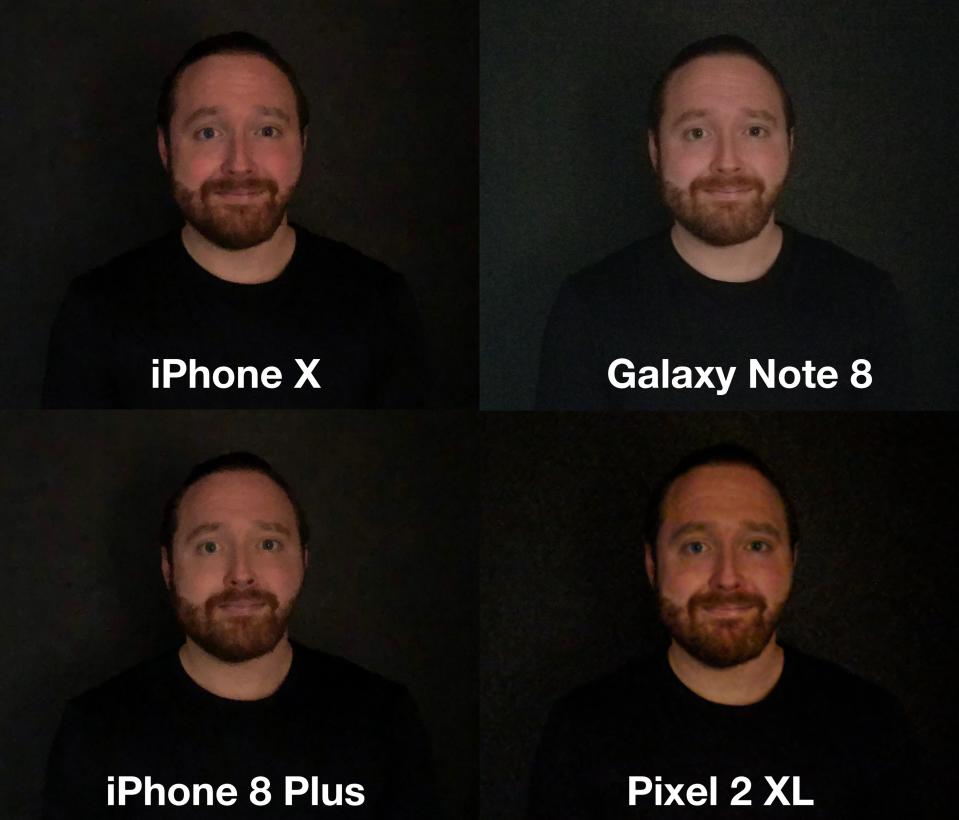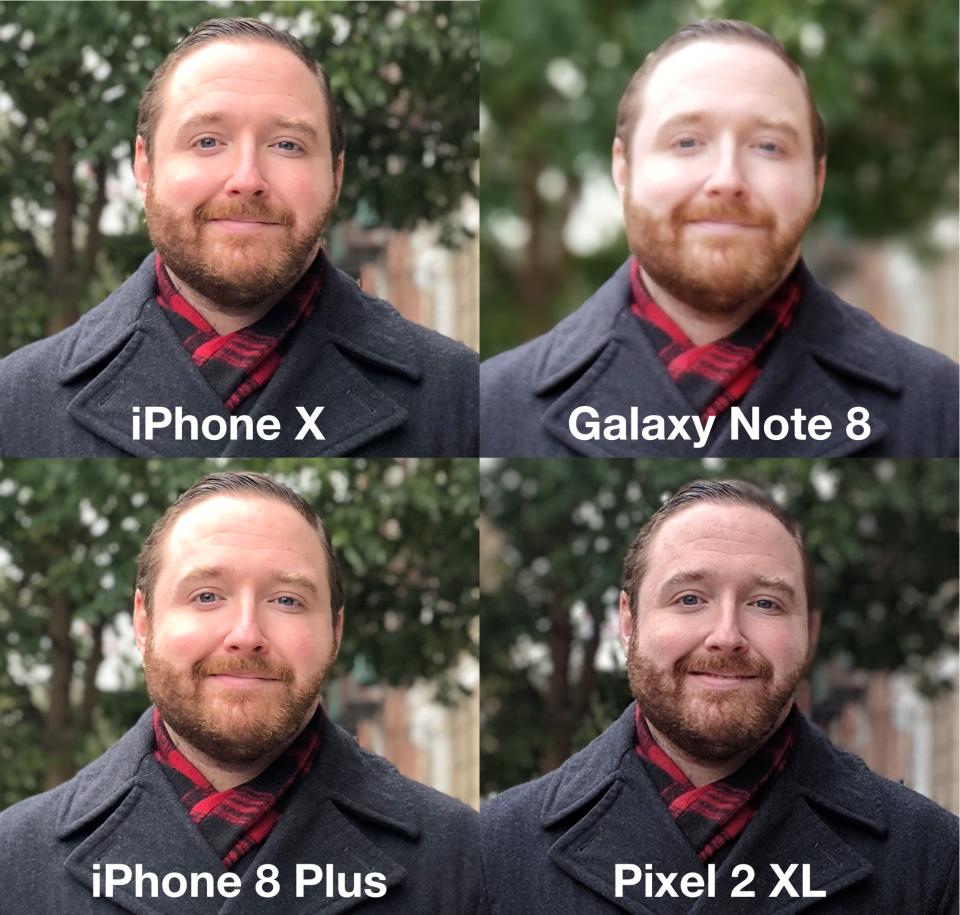Camera showdown: iPhone X, iPhone 8 Plus, Galaxy Note 8, and Pixel 2

Apple’s iPhone X is an exceptional smartphone. It’s easily the best iPhone the tech giant has ever produced thanks to its improved design, vivid edge-to-edge screen and fantastic Face ID facial recognition scanner.
But the iPhone X has another feature that hasn’t gotten quite as much attention as its ability to use animojis: its camera. See, the iPhone X’s shooter features a dual-lens setup that’s much like the 8 Plus. However, it can capture more light than the 8 Plus’s camera, making for improved image quality.
To test how well the iPhone X’s camera performs, I put it up against the 8 Plus, Google’s Pixel 2 XL and Samsung’s Galaxy Note 8. And while each of the handsets performed incredibly well, Apple’s (AAPL) iPhone X outperformed them where it mattered.
Low-light, no flash

Taking low-light photos is one of the most difficult tests for smartphone cameras. And because of that, no single handset can capture the kind of shots a dedicated camera can take. That said, the iPhone X does the best job of the four phones tested of taking low-light photos.
With the phone’s flash off, the X picked up my reddish skin tone better than the iPhone 8 Plus, which made me look too pale. The Note 8 was able to capture more details in my shirt and created a brighter image, but at the expense of making my skin look more washed out. The Pixel 2 XL pulled up the rear in this test, with photos offering a greater degree of pixelation.
Winner: iPhone X
While each handset struggled to capture solid photos in this setting, the Note 8 took the picture that looked best. It made me look washed out, but was less pixelated than others and offered more detail.
Low-light, with flash

With the flash on, the iPhone X offered better coloring than the 8 Plus, especially when it came to my blue shirt. The 8 Plus, on the other hand, made my features look softer than they should.
Samsung’s Galaxy Note 8 made my skin look a bit washed out, but the result was better than Google’s (GOOG, GOOGL) Pixel 2 XL, which made my skin look ghostly white.
Winner: iPhone X
Both the iPhone X’s and 8 Plus’s flashes captured my reddish skin tone without making it look blown out or turning me into Casper.
Zoom

The addition of telephoto lenses to smartphones has made it possible to zoom in on subjects from much farther away than previously possible. But you’ll see varied results across the board. Of the four handsets I tested, all of which I zoomed to about half their max, the iPhone X provided the photo with the most accurate lighting.
While both the iPhone 8 Plus and X capture a similar level of detail, the latter phone captured the more vivid image of the sun’s lighting shining off of the right side of the Empire State Building. The 8 Plus came in second place, while the Note 8 came in third thanks to the level of detail it captured. Still, the Note 8’s picture was too dark.
Google’s Pixel 2 XL, however, falls behind the competition in this round, as it doesn’t offer a telephoto lens with an optical zoom that allows for sharper pictures at a distance. As a result, zoomed images look muddy and lack details.
Winner: iPhone X
The iPhone X captured the clearest shot of the Empire State Building, while retaining the bright colors of the sun reflecting off the tower’s windows.
Colors and whites

I took this photo of a series of soda bottles to help illustrate how each phone’s camera captures colors and whites.
Samsung’s Galaxy Note 8 tends to exaggerate colors more than other phones, which makes them more pleasing to look at, but less accurate. The iPhone 8 Plus also seems to exaggerate colors a bit in this shot, though the white wall and tiles have a yellow hue. The iPhone X captured flatter colors from the bottles and a similarly yellow hue for the walls and tiles.
Interestingly, the Pixel 2 XL produced the shot with the whitest walls and tiles and most colorful bottles without over-exaggerating any specific hue, which means this round goes to Google.
Winner: Pixel 2 XL
Thanks to its ability to capture a colorful shot without making the background appear yellow, the Pixel 2 XL gets the nod in this round.
Portrait mode

The latest must-have feature for smartphones is the ability to take portrait-style photos. I’m talking about those pictures that make the foreground look exceptionally sharp while blurring the background, an effect called bokeh.
The iPhone X, iPhone 8 Plus and Note 8 achieve this effect by combining the images captured by their wide-angle and telephoto lenses. The Pixel 2 XL, on the other hand, uses software and dual-pixels to blur the background while keeping the subject in focus.
Out of the four phones in this group, the iPhone X took the best portrait photo, with few areas of mismatched focus. The only sections that had such issues were incredibly small and around my coat. Details in the photo weren’t lost, either. The iPhone 8 Plus captured a similarly solid image, though with a hair more distortion.
Samsung’s Galaxy Note 8 had more distortion around the edges of my coat than the X and 8 plus, and washed out the details of my face. The Pixel 2 XL, for its part, was the worst of the group. It didn’t fully blur the background, but did blur part of my hair.
Winner: iPhone X and iPhone 8 Plus
Both the iPhone X and 8 Plus captured impressive photos using their portrait modes. And since both images look the same, the phones take home a tie in this round.
Overall winner:
After taking home the win in three of five rounds, and tying for one, the iPhone X comes out the winner of this camera battle.
More from Dan:
Amazon Cloud Cam review: Amazon’s in-home sentry is a great buy
Microsoft Xbox One X review: A beast of a console at a steep price
Email Daniel at dhowley@yahoo-inc.com; follow him on Twitter at @DanielHowley .

 Yahoo Finance
Yahoo Finance 
